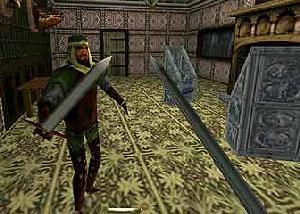Ye Olde Five Fingered Discount.
“Prithee, officer, I’d like to report a robbery. Some rapscallion has run off
with my most prized possession, a jeweled scepter. Apparently, the blighter discovered
a subterranean passage into my manor house. He killed one guard, but the rest
lay unconscious in various parts of the premises. The rogue then apparently made
his way to my throne room . . . yes, I have a throne room, and it’s none of thy
business, constable. Anyway, not only did he steal my scepter, but also he soiled
the waters of my private bath! I want this miscreant found and hung! What does
he look like? He kept to the shadows; all the guards saw was that he had the sloping
brow of a criminal mastermind and the tools of a master thief. You know what those
types look like! Now get out there and do thy job or you will feel the sting of
my whips upon thine tender backside. Away with thee!”
Stagnation is a word I’ve often used to
describe first-person action games on the PC. While certainly fine examples
of the graphical power of today’s computers, games like Unreal
and Quake
II just haven’t cut the mustard for this gamer. Killing everything in sight
loses its charm after about the fourth or fifth time, no matter how beautiful
the game looks. The genre, however, is full of potential, and Thief: The
Dark Project breaks through the monotony to truly accomplish something revolutionary.
Thief separates itself from the rest of the pack by concentrating on the one thing that the frag-fests ignore – complex gameplay. The object of Thief is not to be a one-man genocidal force (no matter how much you idolize Stalin). Rather, stealth is the key. Much like Tenchu: Stealth Assassins for the Playstation, you have to hide in the shadows and sneak up on your enemies. But Thief takes it one step further.
In Tenchu, you simply had to remain out of the line of sight of the enemy. In Thief, however, you not only can be seen, but also heard. Your mere footsteps will alert the guards to your presence. You must constantly be aware as to what surface you’re walking on. Stay quiet, or you might find yourself on the business end of a sword.
On top of that, light plays a heavy role (pun intended). You can be staring a guard directly in the face, but if you’re hidden in the shadows, he’ll never see you. Simply wait until his back is turned, and then let him have it!
By “it,” I am not referring to slaughtering him in an OJ-esque fashion. You’re a thief, not a murderer. You only kill if you have to. The weapon you’ll find yourself using the most is the blackjack, a little club that sends unaware guards off to Slumberland. Sorry, a chaingun is not allowed.
You do have your trusty bow, however, with seven different types of arrows. You can use water arrows to extinguish torches and wipe away bloodstains, moss arrows to lay a path upon which you can walk without being heard, and noisemaker arrows to distract guards that just won’t turn around. Sure, you have regular arrows as well, and a well placed bolt will remove an enemy. You’d better not miss, because a guard with an arrow in his arm makes a hell of a lot of noise.
 Speaking of the guards, the enemy AI you
Speaking of the guards, the enemy AI you
encounter is smarter than the proverbial average bear. Guards pay close attention
to their surroundings and take notice the moment anything is awry. Bloodstains
on the carpet, a tiny bit of noise, or the slightest bit of movement in the
shadows will send the guards investigating. If you hide, they may return to
their normal business. If their suspicions are confirmed, all hell breaks loose.
Since this is a time when instant communications didn’t exist, guards are only
able to summon other guards that are within earshot. Of course, everyone hears
the emergency gong (except Gene Gene the Dancin’ Machine…that’s one helluva
reference… Ed).
Since this is a first-person game, everyone pays close attention to the graphical
engine. Don’t worry folks, the designers at Looking Glass did an excellent job
creating a brand new engine to fit their needs. Though not as beautiful as the
Unreal engine, I found that Thief looks and runs better than Unreal
ever did on my machine (P266 w/ Voodoo card). It requires less to look great.
Ok, so the gameplay is fantastic, the enemies are smart, and the graphics are good . . . but what about the sound? In a word, fantastic. In no game I have ever played have I been able to hide in the shadows and listen to people carry on a conversation, literally. Two guards were discussing how bear-fighting (like cock-fighting, but with bears) was better in the olden days. The world they’ve created is so immersive, I found myself wanting to head to the pits and bet on Smokey myself.
The only significant drawback I’ve found in Thief is the obvious lack of a multi-player option. The game was designed as a one player game, so a multi-player would have been complicated to do. They could have had missions that could only be solved with multiple thieves, but any sort of a deathmatch would go against everything that this game is about.
In the end, what we have here is the best use of the first-person engine that I have ever encountered. In a world full of Doom clones, it’s good to see that some designers are still thinking for themselves. If you’re tired of killing everyone you meet (though who could be tired of that), you should give Thief a try. But don’t blame me if your girlfriend leaves you due to neglect.
-
Amazing Gameplay.
-
Good Graphics.
-
Excellent AI.
-
Great sound.
-
No Multiplayer.







